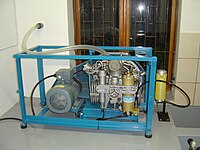
Photo from wikipedia
We study the collective phenomena and constraints associated with the aggregation of individual cooling units from a statistical mechanics perspective. These units are modeled as thermostatically controlled loads (TCLs) and… Click to show full abstract
We study the collective phenomena and constraints associated with the aggregation of individual cooling units from a statistical mechanics perspective. These units are modeled as thermostatically controlled loads (TCLs) and represent zones in a large commercial or residential building. Their energy input is centralized and controlled by a collective unit-the air handling unit (AHU)-delivering cool air to all TCLs, thereby coupling them together. Aiming to identify representative qualitative features of the AHU-to-TCL coupling, we build a simple but realistic model and analyze it in two distinct regimes: the constant supply temperature (CST) and the constant power input (CPI) regimes. In both cases, we center our analysis on the relaxation dynamics of individual TCL temperatures to a statistical steady state. We observe that while the dynamics are relatively fast in the CST regime, resulting in all TCLs evolving around the control set point, the CPI regime reveals the emergence of a bimodal probability distribution and two, possibly strongly separated, timescales. We observe that the two modes in the CPI regime are associated with all TCLs being in the same low or high airflow states, with an occasional collective transition between the modes akin to Kramer's phenomenon in statistical physics. To the best of our knowledge, this phenomenon has been overlooked in building energy systems despite its direct operational implications. It highlights a trade-off between occupational comfort-related to zonal temperature variations-and energy consumption.
Journal Title: Physical review. E
Year Published: 2022
Link to full text (if available)
Share on Social Media: Sign Up to like & get
recommendations!